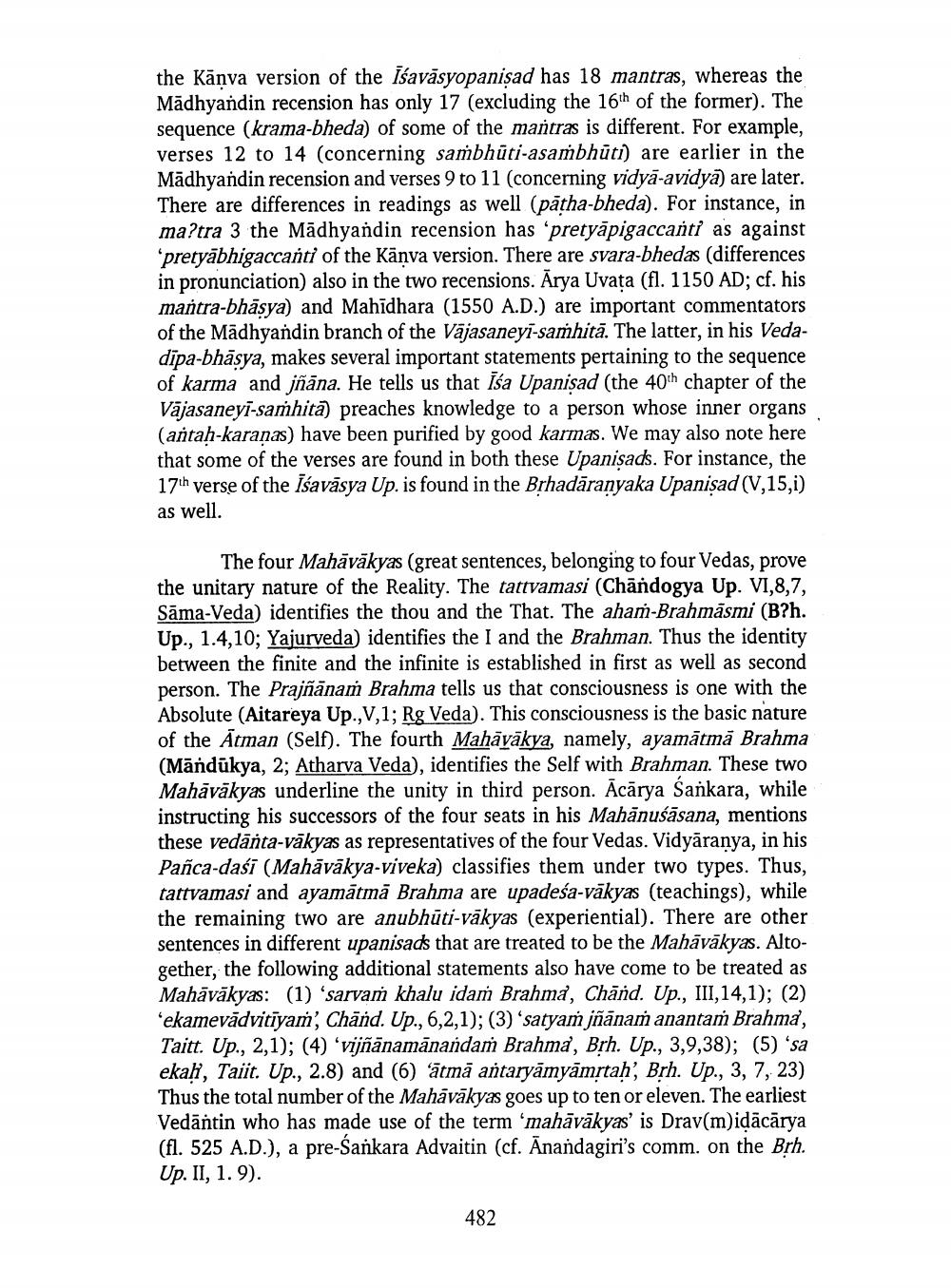________________
the Kānva version of the Isavāsyopanişad has 18 mantras, whereas the Mădhyandin recension has only 17 (excluding the 16th of the former). The sequence (krama-bheda) of some of the mantras is different. For example, verses 12 to 14 (concerning sambhūti-asaṁbhūti) are earlier in the Madhyandin recension and verses 9 to 11 (concerning vidyā-avidya) are later. There are differences in readings as well (patha-bheda). For instance, in ma?tra 3 the Madhyandin recension has 'pretyāpigaccanti as against pretyābhigaccanti of the Kanva version. There are svara-bhedas (differences in pronunciation) also in the two recensions. Ārya Uvata (fl. 1150 AD; cf. his mantra-bhâsya) and Mahīdhara (1550 A.D.) are important commentators of the Madhyandin branch of the Vajasaneyi-saṁhitā. The latter, in his Vedadipa-bhasya, makes several important statements pertaining to the sequence of karma and jñāna. He tells us that isa Upanisad (the 40th chapter of the Vājasaneyi-saṁhita) preaches knowledge to a person whose inner organs (antah-karanas) have been purified by good karmas. We may also note here that some of the verses are found in both these Upanisads. For instance, the 17th verse of the Isavāsya Up. is found in the Brhadāranyaka Upanisad (V,15,i) as well.
The four Mahāvākyas (great sentences, belonging to four Vedas, prove the unitary nature of the Reality. The tattvamasi (Chāndogya Up. VI,8,7, Sāma-Veda) identifies the thou and the That. The ahaṁ-Brahmāsmi (B?h. Up., 1.4,10; Yajurveda) identifies the I and the Brahman. Thus the identity between the finite and the infinite is established in first as well as second person. The Prajñānaṁ Brahma tells us that consciousness is one with the Absolute (Aitareya Up., V,1; Rg Veda. This consciousness is the basic nature of the Atman (Self). The fourth Mahāvākya, namely, ayamātmā Brahma (Māndūkya, 2; Atharva Veda), identifies the Self with Brahman. These two Mahāvākyas underline the unity in third person. Acārya Sankara, while instructing his successors of the four seats in his Mahānusāsana, mentions these vedānta-vākyas as representatives of the four Vedas. Vidyāranya, in his Pañca-dasi (Mahāvākya-viveka) classifies them under two types. Thus, tattvamasi and ayamātmā Brahma are upadeśa-vākyas (teachings), while the remaining two are anubhūti-vākyas (experiential). There are other sentences in different upanisads that are treated to be the Mahāvākyas. Altogether, the following additional statements also have come to be treated as Mahāvākyas: (1) 'sarvaṁ khalu idaṁ Brahma, Chand. Up., III, 14,1); (2) ‘ekamevādvitīyam, Chāṁd. Up., 6,2,1); (3) 'satyam jñānam anantaṁ Brahma, Taitt. Up., 2,1); (4) 'vijñānamānandam Brahma, Brh. Up., 3,9,38); (5) 'sa ekah, Taiit. Up., 2.8) and (6) ātmā antaryāmyāmrtah, Brh. Up., 3, 7, 23) Thus the total number of the Mahāvākyas goes up to ten or eleven. The earliest Vedāntin who has made use of the term 'mahāvākyas' is Drav(m)idācārya (fl. 525 A.D.), a pre-Sankara Advaitin (cf. Ānandagiri's comm. on the Brh. Up. II, 1. 9).
482




